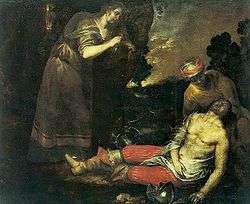Luciano Borzone
Luciano Borzone (1590 – 12 July 1645) was an Italian painter of a late-Mannerist and early-Baroque styles active mainly in his natal city of Genoa.

Biography
After an apprenticeship with Filippo Bertolotto, his uncle, the Duke Alberigo of Massa Lunigiana patronized his work as a pupil of Cesare Corte. He was a prominent portrait painter. In Genoa, he painted the Presentation in the Temple for the church of San Domenico, and the Baptism of Christ for the church of Santo Spirito. Supposedly died from a fall from scaffolding while painting a picture of a Nativity for ceiling of the Nunziata del Vastato.[1] His three sons, Giovanni Battista and Carlo (both who died of the plague in 1657), and Maria Francesco (1625–1679) were also painters. Additional disciples were Giovanni Battista Mainero, Giovanni Battista Monti, Gioacchino Assereto, and Silvestro Chiesa.
He etched some plates from his own compositions: Portrait of Giustiniani; St. Peter delivered from Prison; Prometheus devoured by the Vulture; Children playing; and a set of devout subiects. Maria Francesco, the third son, excelled in painting landscapes and sea-pieces in the style of Lorrain and Pouissin, and came to be employed at the court of Louis XIV. He was born in 1625, and died in 1679.
References
| Wikimedia Commons has media related to Luciano Borzone. |
- R. Soprani p. 252.
- Bryan, Michael (1886). Robert Edmund Graves (ed.). Dictionary of Painters and Engravers, Biographical and Critical (Volume I: A-K). York St. #4, Covent Garden, London; Original from Fogg Library, Digitized May 18, 2007: George Bell and Sons. p. 160.CS1 maint: location (link)
- Soprani, Raffaello (1769). Carlo Giuseppe Ratti (ed.). Delle vite de' pittori, scultori, ed architetti genovesi; Tomo secundo scritto da Carlo Giuseppe Ratti. Stamperia Casamara in Genoa, dalle Cinque Lampadi, con licenza de Superiori; Digitized by Googlebooks from Oxford University copy on Feb 2, 2007. pp. 243–254.
- Camillo Manzitti, "Riscoperta di Luciano Borzone, in "Commentari", n. 3, Luglio-Settembre 1969.
Camillo Manzitti, "Influenze caravaggesche a Genova e nuovi ritrovamenti su Luciano Borzone", in "Paragone", n. 259, Settembre 1971.